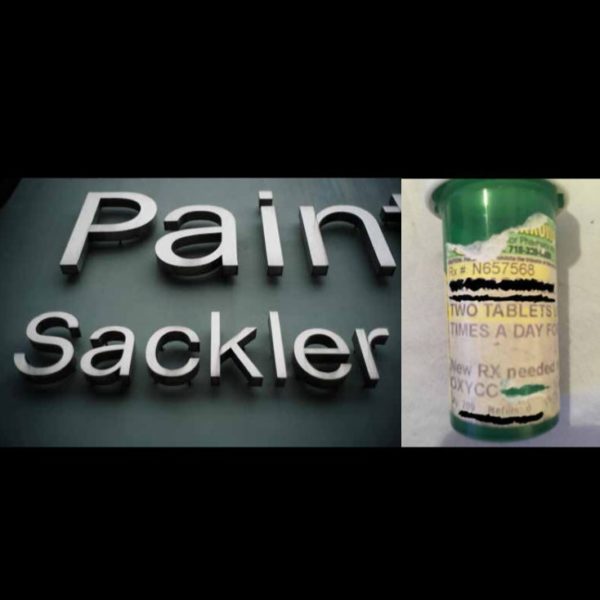 Nan Goldin, Pain/Sackler, Royal College of Art, London, 2017, and Oxy Script, 2017.
Nan Goldin, Pain/Sackler, Royal College of Art, London, 2017, and Oxy Script, 2017.
Corporations and art museums have become more closely connected in recent decades because each benefit greatly from the alliance. The businesses and their owners enjoy good PR and tax write-offs, and the museums get the financial support that is so desperately needed; however, this partnership is not without its complications.
The artist Nan Goldin first rose to fame for her photographs documenting her life with her “tribe” in the drug-fueled, post-punk subculture of the 1980s in New York City. Today she is in the public eye again, this time as a recovering addict to the narcotic painkiller OxyContin who is attacking the company that manufactures the medication, Purdue Pharma, and its owners, the Sackler Family, who are major patrons of the arts.
Arthur, Mortimer, and Raymond Sackler, all of whom were physicians, were among the most generous of American philanthropists, donating millions to the Guggenheim, the Louvre, and the Metropolitan Museum of Art among other art and educational institutions. Although all three of the brothers have died, their children continue their philanthropy today.
The Sackler family amassed most of their enormous fortune in recent decades – a reported 35 billion dollars – from the sale of OxyContin which was developed by their private family business, Perdue Pharma.
If you have even glanced at the news in the last year, you have learned that there is a major opioid drug crisis in America that many experts attribute to the over-prescription of the drug OxyContin, which was aggressively lobbied in Congress and marketed as “safe and effective” when, in fact, it is highly addictive. An estimated 75% of people with an opioid addiction today began with prescription painkillers that they received from their doctor. Many addicts who eventually find themselves unable to afford the prescription painkillers turn to heroin and the cheaper and far more powerful narcotic fentanyl. Currently, overdose deaths related to prescription drugs, heroin, and fentanyl have reached epidemic levels have become the leading cause of death for people under 50 in the United States.
Nan Goldin became addicted to OxyContin when she was prescribed the painkiller following surgery she had in Berlin. After a year of terrible addiction and then treatment, she formed a group called P.A.I.N. (Prescription Addiction Intervention Now) to hold the Sacklers accountable for the role they played in the opioid crisis. In a public statement accompanied by this photograph, Goldin wrote, “They have washed their blood money through the halls of museums and universities around the world. We demand that the Sacklers and Purdue Pharma use their fortune to fund addiction education programs.” She also is calling on museums and universities to refuse future donations from the Sacklers and initiate social media presence to correct misinformation about opioids.
We will see how this all plays out.
For an article about the Sacklers by Patrick Radden Keefe published in the New Yorker a few months ago, click here.
For a synopsis of the opioid epidemic that appeared in the New York Times in August 2017, click here.
For an essay about Nan Goldin’s photographs from the 1980s, click here.


